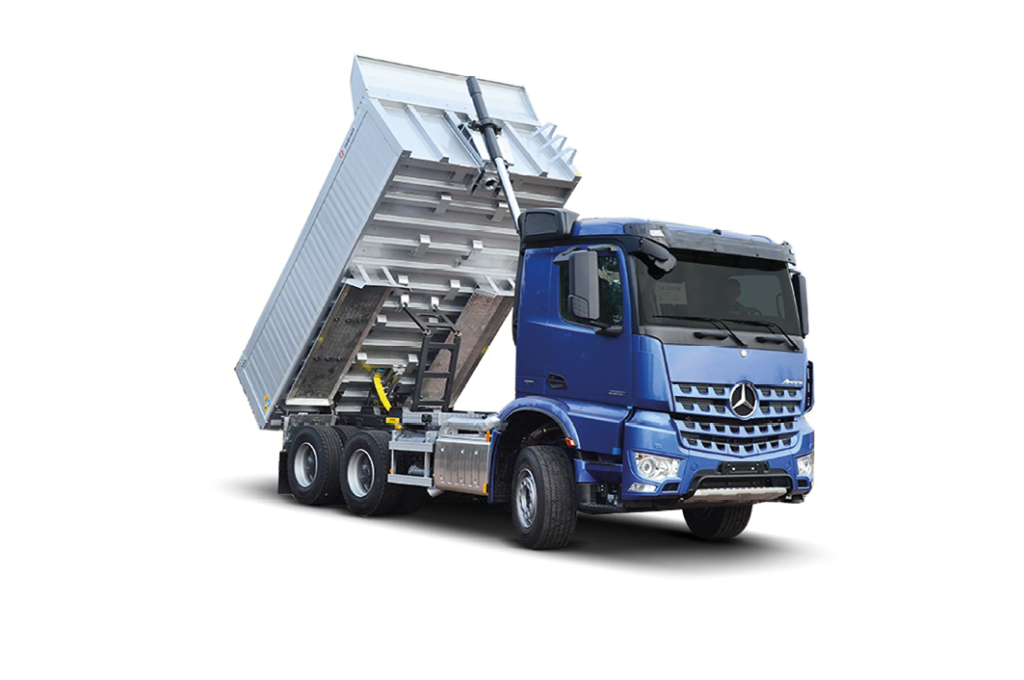An aluminium tipper body is ideal for transporting lightweight, high-volume materials. Thanks to the use of aluminium—much lighter than steel—the vehicle achieves increased payload capacity while maintaining a low kerb weight.
Key features of aluminium tipper superstructures
 Aluminium body construction
Aluminium body construction
The tipping box is made of aluminium, which ensures low weight and high corrosion resistance. This enhances payload potential and structural durability. The solution is ideal for transporting low-density bulk materials and other lightweight cargo.
 Rear tailgate options
Rear tailgate options
The upper tailgate is an aluminium swing-type panel that facilitates loading and unloading. The lower tailgate is 400 mm high, hydraulically controlled and opens automatically, allowing precise material discharge – particularly useful for granular or loose cargo.
 Front-mounted hydraulic cylinder
Front-mounted hydraulic cylinder
A robust, high-performance hydraulic cylinder is used for body lifting, ensuring smooth and safe tipping. The front-mounted configuration provides optimal force distribution, increasing the vehicle’s stability during unloading operations.
 Customizable hydraulic tank and pump parameters
Customizable hydraulic tank and pump parameters
The hydraulic oil tank capacity and pump specifications are configured according to the client’s specific operational requirements..
 VBG coupling system
VBG coupling system
Each tipper body is equipped with a VBG coupling, ensuring safe and reliable connection with various trailer types. This enhances the operational flexibility and versatility of ISTRAIL vehicles.
Available chassis accessories
- additional wear plate (HB 450 steel, 3 mm thick) bolted to the floor for extra protection
- plastic fenders (Parlok-type) or fenders made of aluminium / stainless steel
- open chain boxes and lockable toolboxes mounted on the chassis frame
- pneumatically controlled coupling (Luftservo)
- chain hooks

What else to know about aluminium?
- Using aluminium in the Audi A8 body reduced the vehicle’s weight by 239 kg.
- Lighter electric vehicles using aluminium can travel further on a single charge.
- Aluminium is widely used in shipbuilding—ferries, yachts, and naval vessels—due to its low weight, corrosion resistance, and machinability.
- Trains like the French TGV use aluminium in their structures to enhance speed and capacity.
- Aluminium is fully recyclable and retains its properties after recycling.
- Recycling aluminium uses only 5% of the energy required for primary production, reducing energy consumption and CO2emissions.
Advantages of aluminium tipper superstructures
- Lightweight design
- Aluminium bodies reduce the vehicle’s overall mass, increasing payload efficiency and lowering fuel consumption.
- High corrosion resistance
- The inherent corrosion resistance of aluminium extends the service life of the superstructure, especially under harsh environmental conditions.
- Aesthetic appeal
- Aluminium bodies offer a modern, professional appearance – contributing to a strong brand image for transport operators.
- Environmental sustainability
- Aluminium is 100% recyclable and supports sustainability objectives and eco-friendly transport policies.
- Versatility
- Aluminium superstructures are suitable for transporting high-volume, lightweight goods across a wide range of industries.